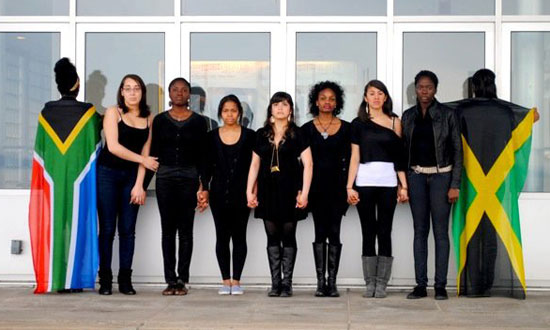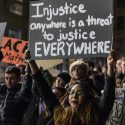Student photo campaign aims to end gender-based violence

Featuring the flags of South Africa and Jamaica in one of the images from the group’s photo campaign, from left, are Delphine B. Vakunta, Hadeel Has, Chika Onwuvuche, Taren Mansfield, Caresse Rios, Erika Dickerson-Despenza, Lauren Lugo, Oreofe Laditan, and Jasmine Calvin.
As she prepares for a year in South Africa, University of Wisconsin–Madison junior Erika Dickerson-Despenza has many priorities: saying goodbye to friends, adapting to a new culture.
But as her own life changes, she hopes to change the lives of others as well.
A member of the First Wave Spoken Word and Hip Hop Arts Learning Community, Dickerson-Despenza and her new student organization, The For Colored Girls Project, use their artistic talents to draw attention to issues facing women of color around the world. Their ongoing photo campaign spotlights gender-based violence affecting women, like themselves, living half a world away.
Researching issues of gender in South Africa, Dickerson-Despenza found a new report about corrective rape, a phenomenon in which men assault women who identify as non-heterosexual in order to “correct” the women’s sexual orientation. The issue hit home for her group, some of whose members identify outside the norms of gender and sexual orientation.
“I’m traveling to a country where 150 women are raped every day!” says Dickerson-Despenza. “This issue mattered to us.”
Wrapped in the flags of South Africa and Jamaica, the black-clad women in the photos hold signs with statistics about rape in these countries. “For every 100 men charged with rape in South Africa, 96 of them walk free,” reads one. Another simply says “We ARE our sisters’ keepers.”
“Pictures are accessible and haunting,” says Dickerson-Despenza. “One may forget words, but never an image.”
Describing a photo campaign as “inviting,” she notes that it is accessible to people from any region of the world, making it easy to both view and participate. The campaign’s genesis reflects this accessibility: once she brought the idea to the project’s executive board, group members began taking photos almost immediately. (In addition, public service announcements recorded in both English and Spanish extend the effort to the audio realm.)
Activism is central to the mission of The For Colored Girls Project, a theater ensemble made up of a rotating cast of women of color. Named after a 1975 choreopoem by Ntozake Shange, the group navigates intersections of race, ethnicity, gender, class, sexual orientation, and disability through the varied talents of its members.
The project provides performers from often-marginalized groups with the space and support to respond to the world in their own way.
“The For Colored Girls Project is important because ‘colored girls’ are important,” says Dickerson-Despenza. “Each woman of color is unique and, indeed, specific.”
While Dickerson-Despenza spends the next year abroad, seniors Chloe Longmire and Lauren Lugo will lead much of the work, serving as co-directors for the general production. This December, the organization plans to welcome playwright Rhodessa Jones to campus in conjunction of its production of Jones’ “Big Butt Girls, Hard Headed Women.” The play focuses on issues of incarceration, motherhood, classism, and the prison industrial complex as they relate to women of color.
Aside from performances, the group takes part in volunteerism, workshops and dialogues throughout the year. In addition, students from other universities have reached out to the group in hopes of initiating chapters throughout the country.
As Dickerson-Despenza travels from Cape Town through South Africa and surrounding countries, she will study the ways in which cultural, artistic and educational worlds converge. She has found the same convergence here on campus, from creating thought-provoking performances to using art as a means to invigorate English students at Madison’s West High.
She describes her First Wave family as some of her greatest supporters, providing encouragement and community development experience that empowers her to strike out on her own.
“Ultimately, the greatest support has been the sharing of resources,” she says. “That’s what community is all about.”
To listen to The For Colored Girls Project’s three-minute audio public service announcement, click here.
More information on the For Colored Girls Project, including the photo campaign, is available at thefcgproject@gmail.com.
Tags: diversity, student life



